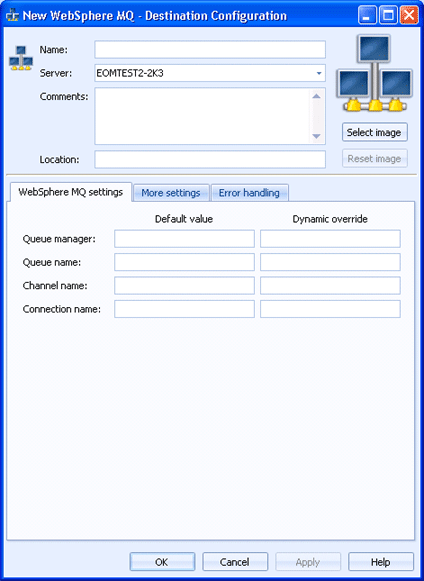
Destinations
WebSphere MQ is a message queuing system designed by IBM that runs on many platforms such as Windows, Unix, Linux, and z/OS. Barr EOM provides an interface into that queuing system. Barr EOM can then communicate (send and receive messages) with other applications using WebSphere MQ.
Use this tab to configure a WebSphere MQ destination. Documents routed to this destination will be sent as WebSphere MQ messages. You can access this tab when you create or configure a WebSphere MQ destination.
To use this destination, a WebSphere MQ client must be installed separately.
You can configure a default value and a dynamic override for each option. Default values are used to manage the documents as they are being sent to the destination. You can choose to dynamically override the default values using document properties. To enter an override value, right-click in the desired override text box and select Insert Document Property. A menu containing all of the available properties displays. You can select a property from the list or type the property name. If a property is selected and it contains a value, that value is processed instead of the default value.
Click an option you want to learn more about.

Specifies the name of the WebSphere MQ destination.
Specifies the Barr EOM server where the Barr EOM Output Service is located for this destination.
Lists any general comments about the destination.
Specifies any specific location information for the destination.
Displays a WebSphere MQ destination image. To change the destination image, click Select Image and choose the appropriate image file (.bmp, jpg, or png). The selected image will be compressed and scaled to 96x96 pixels. Changing this image will not change the smaller image that displays or the image that displays in the destination tree. To change the image back to the default, click Reset Image.
Specifies the name of the queue manager. This must match the queue manager specified in WebSphere MQ. The queue manager administers the queues that have been created on it (these are known as local queues).
Specifies the queue name where messages sent to this destination will be stored. This must match the queue name specified in WebSphere MQ. The queue name along with the name of its queue manager, provides a unique address where messages can be sent.
Each WebSphere MQ queue manager has different types of connectivity options. Since Barr EOM uses TCPIP for the channel connection, you must specify the channel configured for TCPIP. You can get this name from the WebSphere MQ list of channels.
Make sure the SSL certificate required option is not selected in WebSphere MQ. Barr EOM does not support this at this time.
Specifies the connection name. The connection name is the IP address and (port) or DNS name for the server to which you are attempting to connect. Messages are transferred over the connection and placed in the queue.